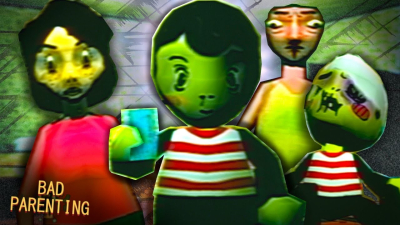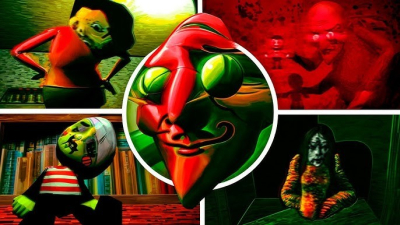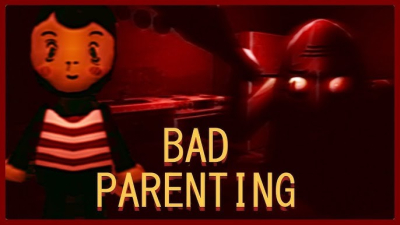Bad Parenting
From the moment I launched Bad Parenting 1: Mr. Red Face, I knew I was about to embark on an experience unlike any other. The game immediately transported me into a universe where everyday family challenges are twisted into something both humorous and unexpectedly challenging. I approached the game with both trepidation and anticipation, ready to witness the outrageous scenarios that would force me to confront a distorted yet oddly familiar reflection of parental responsibilities. Navigating the game’s opening menu, I could sense that each decision made and interaction encountered would unlock layers of unpredictability and richly woven narrative twists throughout the experience.
My First Encounter with Mr. Red Face
My initial moments with Mr. Red Face were filled with an amalgam of surprise, amusement, and a touch of disbelief. As I stepped into the shoes of a character who was designated the misfit of the family, I quickly realized that the journey was not a conventional simulation but an exploration of societal norms through a darkly humorous lens. The character, whose design is sharply etched with expressions that range from bewilderment to ironic pride, immediately drew me in. I found myself empathizing with his struggles in a way that was both entertaining and unsettling, as the game portrayed the absurdities of modern parenting in a stark, unfiltered manner.
Innovative Gameplay Mechanics and Interactivity
The interactivity in Bad Parenting 1 is something that truly captivated me. The game’s control system, while seemingly straightforward at first, revealed depth as I progressed through the levels. Every action I took—from mundane tasks to bizarre mini-challenges—was packed with unexpected complications that forced me to constantly adapt my strategy. I enjoyed how the mechanics encouraged experimentation rather than simply penalizing mistakes. The feedback loop was immediate and, at times, hilariously punishing, which made every successful maneuver that much more satisfying. The game invites you to think creatively and engage with tasks in multiple valid ways, making each playthrough feel fresh and unpredictable.
Exploring the Narrative and Its Unconventional Themes
One of the aspects that truly resonated with me was the narrative depth behind the game’s premise. Bad Parenting 1 cleverly subverted the traditional roles found in family simulations. As I maneuvered through storylines that highlighted both comedic and tragic elements, I felt an evolving connection to the characters. The game does not shy away from probing the vulnerabilities of its protagonists, touching on themes of regret, ambition, and the complexity of family dynamics. Every dialogue and interaction is crafted to expose the inner conflicts of a character grappling with a society that expects perfection but is inherently flawed. This realization became a mirror for my own experiences, and I found solace in the game’s candid portrayal of imperfection.
Visually Arresting Aesthetic and Unique Art Style
The artistic direction of Bad Parenting 1 immediately set itself apart. I found that the game’s art style was a deliberate blend of cartoonish exaggeration and grittier realism. The character animations, color palettes, and shadow work were all designed to evoke a sense of quirky dysfunction. Every scene felt as though it had been carefully curated to balance humor with the stark realities of parental challenges. The visual choices mirrored the game’s narrative: vibrant in moments of levity and subdued during introspective sequences. I appreciated the way the game manipulated visual aesthetics to amplify the emotional weight behind each scenario. As I spent hours exploring finely detailed backgrounds and cleverly animated sequences, I couldn’t help but admire the artistry behind each frame.
Engaging Audio Design and Immersive Soundtrack
The sound design in Bad Parenting 1 had an immediate impact on my overall immersion. The soundtrack, which combined elements of quirky tunes with more dramatic undertones, played a crucial role in setting the tone for each moment. What captivated me most was how the ambient sounds overlapped with the musical score to intensify both the mundane and the extraordinary moments in the game. I was particularly drawn to how the sound effects amplified my actions, whether I was navigating a simple conversation or engaging in a more elaborate sequence. The attention to detail in the audio provided depth to the game’s universe, making every interaction feel more personal and every challenge more engaging. I often found myself pausing to appreciate how expertly the layers of sound complemented the visual storytelling.
Personal and Emotional Connection with Characters
As I continued playing, I discovered that the characters in Bad Parenting 1 are more than just caricatures designed for comic relief. I was drawn into their personal stories, each laden with their own quirks and hidden pains. In particular, the character of Mr. Red Face exhibited a poignant blend of humor and vulnerability that managed to evoke real empathy from me as a player. The dialogue, rich with wit and underlying emotion, revealed layers of complexity that transformed the caricature into someone I could genuinely relate to. I found that this emotional bond enriched the game experience, making every hardship and humorous misadventure feel all the more impactful. The game allowed me to experience both the lighter side of life’s absurdity and the deeper, sometimes somber, moments behind everyday decisions.
Satirical Humor and Social Commentary
Humor in Bad Parenting 1 is not mere slapstick—it’s a delicate balance of satire woven into commentary on societal expectations. As I progressed through the challenges, I was struck by how the game uses ironic humor to reflect on the complexities of modern society and the sometimes unrealistic standards imposed on individuals. This clever blend of satire and social commentary had me constantly reconsidering the role of parenting as depicted by both the game and in real life. The narrative provided a platform that both entertained and subtly critiqued various cultural norms. I enjoyed how the game managed to provoke thought through its funny yet poignant approach, underlining that even in the midst of absurdity, there are serious matters to be explored.
Strategic Puzzle Elements and Problem-Solving Dynamics
One of the most compelling challenges I encountered during my gameplay was the integration of strategic puzzles into the overall structure of the game. These were not your standard puzzles; instead, they required me to merge logic, intuition, and a healthy dose of creativity. Every puzzle I worked through presented a unique problem that tested my adaptability and patience. I found that the satisfaction of eventually overcoming these obstacles was deeply rewarding. The integration of these puzzles into the context of dysfunctional family scenarios made each solution feel more impactful, intertwining the mechanics of gameplay with the themes of order and chaos. The thrill of intellectual discovery during these moments kept me constantly engaged, as I eagerly anticipated what new conundrum awaited me at each twist in the story.
Unpredictable Game Controls and Interface Innovations
At first, the game’s control interface appeared deceptively simple; however, as I immersed myself deeper into the experience, I discovered a surprising level of nuance that demanded my full attention. Exploring the intricacies of the control scheme was much like exploring an elaborate puzzle in itself. I appreciated how intuitive actions quickly gave way to a more refined understanding of game dynamics as I progressed further. Experimenting with the various interactive elements led me to stumble upon hidden functionalities and clever shortcuts that enriched my understanding of the game’s potential. The user interface, with its minimalist design that did not sacrifice functionality, underscored the developer's commitment to ensuring that the gameplay remains both challenging and accessible for players of diverse skill levels.
Balancing Humor with Real-Life Reflections
As a player with a reflective mindset, I was intrigued by how Bad Parenting 1 managed to balance lighthearted humor with moments of somber introspection. The game’s clever narrative oscillated between absurd scenarios and deeply relatable situations, prompting me to draw parallels with my own experiences. Whether I was navigating through a ludicrous household crisis or a cleverly choreographed sequence of unexpected events, each moment felt imbued with a sense of reality that resonated with my personal understanding of life's imperfections. This juxtaposition of humor and introspection allowed me to appreciate the game on multiple levels, from the ludicrous escapades to the subtle reminders of human frailty. I found it remarkable how the game continuously challenged me to view silly misadventures through a lens tinted with empathy and self-awareness.
Exploring Customization and Replay Value
Another intriguing aspect of my journey was discovering the various ways in which the game encouraged replayability through customization. Bad Parenting 1 offers a wide array of options that affect how the game unfolds, allowing me to tailor both the narrative and the challenge to my personal preferences. I found that experimenting with different settings and decision-making paths led to a multitude of varied experiences, each revealing new layers and perspectives on the game’s core themes. The diversity in gameplay paths demanded that I refine my approach each time, infusing the experience with a sense of freshness that kept my interest alive. The game thoughtfully integrates elements that not only cater to initial novelty but also promise enduring enjoyment as one revisits the universe, enabling a deep dive into the myriad possibilities that each session can offer.
Delving into the Psychological Impact of Gameplay
The psychological layers of Bad Parenting 1 are as enigmatic as they are captivating. In my experience, the game not only served as a medium of entertainment but also opened a reflective window into the complexities of navigating societal expectations. I found that every challenge presented was a metaphor for deeper internal conflicts, prompting me to consider how my own experiences of responsibility, doubt, and self-critique interplayed with the game’s narrative structure. The unfolding events often carried an emotional weight that resonated long after a session had ended, creating a reflective echo that lingered during quiet moments afterward. I was surprised at how a game built on absurd premises could touch on such sophisticated psychological themes, inviting me to ponder life’s unpredictable nature even as I engaged with its humorous elements.
Unanticipated Mechanics and Adaptive Learning Curves
Throughout my adventures in Bad Parenting 1, I encountered numerous unanticipated mechanics that contributed to a steep yet rewarding learning curve. Each new level presented challenges that required me to not only master the existing mechanics but also to adapt to novel gameplay elements introduced in creative ways. I vividly recall moments when I had to devise unconventional strategies to overcome obstacles that initially seemed insurmountable. This dynamic quality kept me on my toes, transforming what could have been monotonous repetition into an evolving landscape of challenges. I combined careful experimentation with an openness to unexpected twists, which made every session a journey of discovery. By embracing these unpredictable mechanics, I felt as though I was continuously learning and adapting—a process that enriched my overall engagement with the game.



















